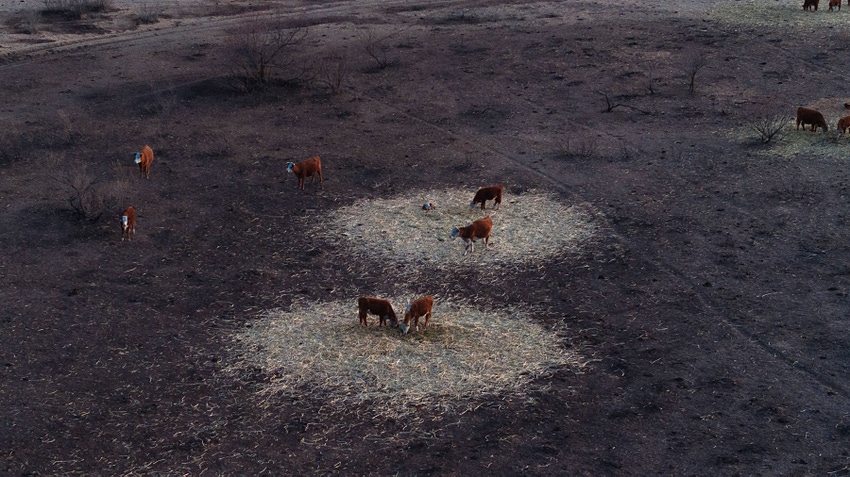
Some two weeks past the onset of the worst wildfire in Texas history, folks are trying to put ranches, residences and lives back together.
“Our people are strong,” says Hemphill County AgriLife Extension Agent Andy Holloway, Canadian, Texas. “We’re still numb as reality is soaking in and ranchers are getting beyond the number of dead cattle and realizing how much fencing must be repaired or replaced,” Holloway said.
“Mentally, it’s difficult. People are not moping and crying but many are having a hard time accepting what’s happened.”
Holloway says the disaster that burned more than 1.05 million acres, much of it in Hemphill County, “is so big, that even in the middle of it I don’t understand the magnitude. It’s a monumental loss greater than anything I have ever seen in our community.”
Lost cattle
Holloway estimates as many as 15,000 head of cattle have been lost in Hemphill and Robertson counties. Hutchinson and Gray also lost cattle, he says, but did not have as many acres burned. “A friend in Gray County lost lots of cattle near Pampa.”
Holloway estimates some 2500 miles of fencing in Hemphill County will be replaced or repaired. The cost is significant. “A new 5- to 6-strand barbed wire fence will cost $15,000 a mile to replace. That’s $150,000 for a ten-mile fence. Not all ranchers have that much money lying around.
“We have a lot to do that will take time and money.
USDA programs will be helpful but not a cure-all. It’s better than a band-aid but will not fix everything that’s been lost.”
The mental strain is hard, Holloway says. “I’m afraid that some ranches will not recover financially. If a rancher lost 100 cows, he needs $300,000 or more to replace them. Those cattle represent his net worth and it’s gone. He also might have 6 to 8 miles of fence to replace. That all adds up and it’s mentally challenging.”
Massive response
Holloway is grateful for the response of people across the country. “God will show us a way through this,” he said. “He already is. Thousands of people across the country have donated money and supplies. We have received more than $1 million worth of hay. That’s a lot of rolls of hay. We’ve received cubes, dog food, clothes, and water, more than you can imagine.”
He adds that the wildfire relief fund has been available for seven or eight business days and has already received several hundred thousand dollars. “One little girl brought in $10 because she wanted to be part of the fund. That money goes directly to ranchers. It’s like a ray of hope, knowing that someone cares.”
Cash and fencing
Holloway says cash is needed. “We’re also telling people to keep bringing hay and cubes, and we badly need fencing supplies, 6-foot t-posts and 12.5 gauge barbed wire.”
The area also needs rain. “I woke up at 4:30 Tuesday and started praying for rain,” Holloway says. “We need a good 3-inch soaking rain. A lot of this country is like the sandhills of Nebraska; without grass we will have a big wind day and sand will blow.”
Benefits
He says in years to come the fire may prove beneficial to rangeland. “I think this fire will be valuable to rangeland if we give the country time to recover and rest. The fire burned a lot of encroaching brush —cedar, mesquite, and cholla. The fire will stop or retard a lot of that growth.”
He says big fires were part of the plains ecosystem before the area became settled. “Wildfires would burn until they burned out. That’s part of what Mother Nature did to reestablish range. Bison grazed until they grazed it down and then left and might not have returned for years. The grass reestablished after bison grazing and wildfires.”
He adds that some excellent forage seeds may have been dormant for years and could emerge following this fire.
Long recovery
“It’s hard to imagine how long it will take to reestablish rangeland,” Holloway says. “We have delicate soils, and it will take a lot of time to recover.”
Patience will be necessary. “If we get rain and grass greens up, some will be tempted to turn cows on it. That could be the worst thing they could do, but it will happen.”
Holloway says recovery will be slow as residents of the burned areas take stock and start to recover. “We have to replace fences, reestablish rangeland, and rebuild homes,” he says.
“We have months, if not years, before we are back to normal. If we get a 3-inch rain and rangeland gets green and pretty, we might think the bad days are behind us, but it will take pastures months, if not years, to recover. But every day is a little better than the day before.
“It’s easy to think inwardly about own situations,” Holloway says. “It’s hard to understand that it could have been worse. We could have suffered more human loss. We are encouraged that we have another day to keep going.”
About the Author(s)
You May Also Like






